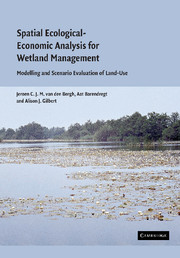 Spatial Ecological-Economic Analysis for Wetland Management
Spatial Ecological-Economic Analysis for Wetland Management Book contents
- Frontmatter
- Contents
- List of figures
- List of tables
- Preface
- 1 Introduction
- 2 Wetlands and science
- 3 Integrated modelling and assessment
- 4 Theoretical framework and method of integrated study
- 5 The Vecht area: history, problems and policy
- 6 Development scenarios for the Vecht area
- 7 The spatial–ecological model: hydrology and ecology
- 8 The spatial–economic model: agriculture, nature conservation and outdoor recreation
- 9 Performance indicators for the evaluation
- 10 Evaluation of the scenarios
- 11 Conclusions: policy and research implications
- References
- Index
5 - The Vecht area: history, problems and policy
Published online by Cambridge University Press: 24 November 2009
- Frontmatter
- Contents
- List of figures
- List of tables
- Preface
- 1 Introduction
- 2 Wetlands and science
- 3 Integrated modelling and assessment
- 4 Theoretical framework and method of integrated study
- 5 The Vecht area: history, problems and policy
- 6 Development scenarios for the Vecht area
- 7 The spatial–ecological model: hydrology and ecology
- 8 The spatial–economic model: agriculture, nature conservation and outdoor recreation
- 9 Performance indicators for the evaluation
- 10 Evaluation of the scenarios
- 11 Conclusions: policy and research implications
- References
- Index
Summary
Description of the area
The Vecht area is a plain with wetlands, located between the river Vecht in the west (Fig. 5.1) and the sandy ice-pushed hill ridge ‘Het Gooi’ approximately 8km to the east. To the north, a former sea (‘Zuiderzee’), now reclaimed, bounds the area; 20km to the south near the city of Utrecht, the hill ridge and the river almost meet (Fig. 5.2). The area is a wetland region with many shallow lakes. Even where a solid soil is present, the groundwater table is close to the surface. The soil diversity is represented by the presence of three types of soil: close to the river and the former sea, there are deposits of clay soils; the centre of the plain is covered by a peat layer some metres in depth; and in the eastern direction this peat layer gets thinner until it reaches the sandy soil of the hill ridge. The area straddles two provinces (North-Holland and Utrecht) and includes 10 municipalities. The number of inhabitants in these areas is restricted. The centres with significant population sizes are mostly at the border of, or just outside, the area (see Table 5.1).
Agriculture and nature dominate land use; industry is almost absent (Fig. 5.3). Agriculture is primarily dairy farming.
- Type
- Chapter
- Information
- Spatial Ecological-Economic Analysis for Wetland ManagementModelling and Scenario Evaluation of Land Use, pp. 89 - 105Publisher: Cambridge University PressPrint publication year: 2004


